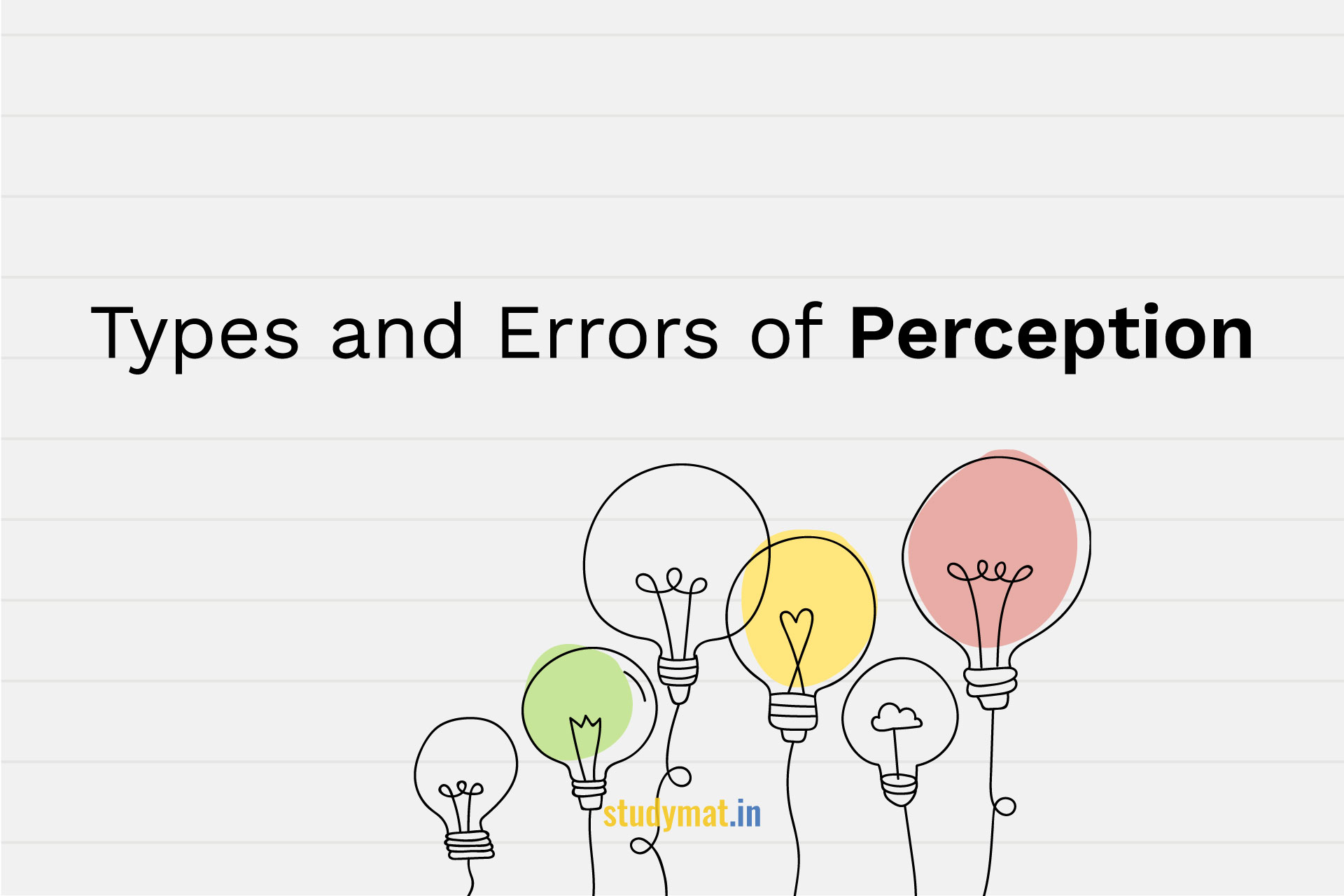In this article, we will discuss What is Perception? Discuss the Types and Errors of Perception.
What is Perception?
Perception is a process of selecting, organizing, and interpreting sensory information.
Types of Perception.
We discuss three types of Perception – 1. Perception of Depth and Distance, 2. Movement Perception, and 3. Size Perception.
1. Perception of Depth and Distance.
Depth Perception refers to one’s visual ability to perceive the world in three dimensions and accordingly enable us to judge an object’s distance. Where the process by which we determine the distance of an object is known as Distance Perception. Our brain uses both Monocular and Binocular Cues to judge depth and distance.
1.1 Monocular Cues:
Monocular Cues are the information or cues that our brain receives from one eye only. These cues are weaker than Binocular Cues. Following are some of the common Monocular Cues:
1.1.1 Relative Size
The Relative Size cue gives us information about the distance of an object based on its relative size with a similar object. This cue works on both two-dimensional and three-dimensional images. The basic premise is that if two objects are of approximately similar size, then the closer object is perceived as larger.
1.1.2 Texture Gradient
Texture Gradient cue is based on our perception of the change in the gradient or degree of texture. The texture of the objects which are nearer to our eyes are rough or distinct, but as we move away from it, the texture of the object will become less distinct or smooth and it signifying the perception of more distance. For Example, if we look at our wall of the room from 30 feet, it seems smoother, but if we look at the same wall from one foot, we can notice the details on the wall. This change in the texture correlates with the distance.
1.1.3 Arial Perspective or Haze
Objects are perceived at a distance if there is a presence of haze in the environment. Haze is the result of atmospheric dust particles, water vapours, or fog. Sometimes the perception of distance based on haze can be misleading. The same mountain can be perceived as nearer or at distance depending on the presence of haze.
1.1.4 Linear Perspective
Linear Perspective cue is based on the convergence of straight lines at a point on the horizon. An appropriate example of this cue might be the perception of convergence of rail tracks at a distance. This cue advises that the closure the lines are; the greater will be the distance.
1.1.5 Interposition/Occlusion
When two objects are overlapped, they will be perceived as farther away than the overlapping object.
1.1.6 Accommodation
Even though accommodation cue appears with both eyes, it is still considered a monocular cue. It is known as an accommodation because the size of our lenses accommodates themselves based on the distance. Our lenses become thicker when an object lies closer to the eyes whereas it becomes thinner when an object lies at a distance.
1.2 Binocular Cues:
Binocular Cues are information that our brain receives from both eyes. These cues are more powerful than Monocular Cues. The process of gaining binocular cues to estimate depth is known as Stereopsis. Following are two types of binocular cues:
1.2.1 Retinal Disparity
We humans have two eyes, separated by the distance of an average of 6.3 cm. Therefore, the retinal image of the same object varies slightly from each other. The closer an object is to the eyes; the greater will be the difference in its retinal image. Our brain analyses the degree of the great difference between these two separate retinal images and produces a single image of the object to judge information on height, depth, and width.
1.2.2 Convergence
Convergence angle is when our eyes make an angle on focusing an object. This angle for nearby and distant objects are different. Our eyes make a smaller convergence angle when an object is at a distance. But our eyeballs rotate inwards and form a large convergence angle when an object is closer to our eyes. This change in convergence gives a hint about depth and distance to the perceiver.
2. Movement Perception.
Movement Perception is our ability to judge the speed and direction of a moving object. Psychologists have tried to answer the questions on movement perception using the following four factors:
2.1 Retinal Motion:
When an object moves, its image on the retina also moves. This motion of the retinal image is detected by special visual neurons which are sensitive to change in motion and direction. We perceive movement in this way.
2.2 Motion After-Effect (MAE):
If we fixate our gaze on a moving object for some time (few seconds to minutes) and then move our gaze to a stationary object. Then the stationary object will be perceived as moving in the opposite direction to the original moving object. This phenomenon is called MAE and occurs due to motion adaption.
2.3 Induced Movement:
When a smaller stationary body is bounded by a larger moving body, then a smaller body is perceived to move in the direction opposite to the larger body. We perceive the moon as moving due to this phenomenon when it is bounded by slowly moving clouds.
2.4 Apparent Movement/Stroboscopic Motion:
It is first given by Gestalt theorist Wertheimer. When stationary stimuli are presented in succession, it is perceived in a motion in this phenomenon. This phenomenon is used to explain movement perception in videos.
3. Size Perception.
Our ability to judge the size of the stimuli correctly even with the change in the distance has been explained using three hypotheses: Size-Distance Invariance Hypothesis, Familiar Size Hypothesis, and Direct Perception Hypothesis.
3.1 Size-Distance Invariance Hypothesis (SDIH):
The basic foundation of this hypothesis is that the perceived size of a stimulus is proportional to the perceived distance (Kilpatrick and Ittelson). It further states that if information about the distance is available, then the stimuli’s size is interpreted based on the retinal image. But, if the information about the distance is not available, then the stimuli’s size is judged grounded on the visual angle alone. The mathematical expression of this relationship is as follows:
S‘/D‘=f(theta sign)
Where,
S‘=perceived size
D‘=perceived distance
Theta= visual angle
Here, before proceeding more, it is important to explain the term “visual angle” first. Our eyes made the angle after looking at the object.
3.2 Familiar Size Theory/Cue:
Familiar Size cues use to judge not only size but also the depth and distance of the stimuli. We know the visual angle for a stimulus decreases with the decrease in the distance. Our brain uses visual angles along with our previous information of the size of the targeted stimulus and determines its actual size, depth and distance. According to this theory, familiar size influences our size perception, which in turn influences our distance perception (Ittelson). Though, later two psychologists (Gogel & Da Silva) suggested that the theory of familiar size is valid in all conditions. When the condition of viewing is improvised then we use egocentric reference distance to determine the size of the familiar object.
3.3 Theory of Direct Perception:
Gibson proposed the Theory of Direct Perception. His ideas about size perception summarized by Epstein as:
“(i) there is no perceptual representation of size correlated with the retinal size of the object,
(ii) perceived size and perceived distance are independent functions of information in stimulation, and
(iii) perceived size and perceived distance are not causally linked, nor is the perception of size mediated by operations combining information about the retinal size and perceived distance. The correlation between perceived size and perceived distance attributed to the correlation between the specific variables of stimulation which governs these precepts in the particular situations”.
Follow us:
If you like this article, you can Follow us on Facebook.
Also, you can Join our Official Facebook Group for QnA Sessions and Discussions with the worldwide IGNOU community.


